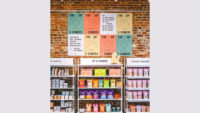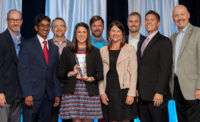Kashi co-founders, Kraft Exec Share Stories, Insights
Prepared Foods New Products Conference Emphasizes Innovation

When Prepared Foods took its 31st annual New Products Conference to San Diego, it turned to some hometown heroes, Gayle and Philip Tauber, for the meeting’s keynote address.
 Gayle Tauber |
The Taubers are better known as the 1983 co-founders of Kashi, the La Jolla, Calif., company that created a whole grain cereal pilaf for athletes and other health-conscious consumers. Today, Kashi is a multi-million dollar brand platform for the Kellogg Company, which purchased the brand in 2000.
Addressing the New Products Conference audience, the Taubers said the key to success—for any company, large or small—is to think and act like an emerging company.
The Taubers were a young, married couple with an entrepreneurial edge in the early 1970s. At the time, they spotted a market gap-opportunity and created their own company specializing in indoor plants. After developing that business, they later sold it and briefly partnered (in 1978) with Vince Gironda, a well-known Los Angeles bodybuilder, gym owner and trainer. Working with Vince, the Taubers soon were at the forefront of private training, the first co-ed gym as well as diet and supplement products for athletes.
Afterward, they moved to San Diego. With growing interest in physical fitness in the late ‘70s and early ‘80s, the Taubers could see growing interest in natural foods that were rich in protein, complex-carbohydrates with a low-fat, low-sodium profile. That led to their experimentation and development of Kashi pilaf cereal mix, which debuted at Natural Products Expo West in 1984. Kashi developed as many as 17 product lines during the next 16 years.
 Phil Tauber |
No less important, the Taubers were marketing mavericks. They pioneered “end-of-the-race feeding” at athletic events; partnered with and/or supported non-profits that used athletic events to promote their causes; created a “Kashi Army” concept (prior to social networking); and developed strategic relationships with targeted influencers such as Pritiken, Jenny Craig, and Weight Watchers.
The Taubers demonstrated how market differentiation provides competitive edge. They emphasized that all the small, detailed points of creative merchandising and market research work together to benefit both the manufacturer and consumer. They stressed the importance of observing consumer interaction with a manufacturer’s product—both at the store and in the home.
Addressing the topic of innovation, the Taubers said NPC attendees must look for breakthrough ideas that lead to innovative success—chiefly through the vision required to solve a problem. They deemed it “innovision” and outlined seven process steps:
 Barry Calpino |
1.Define the mission vision, explore the goals of what could be.
2.Determine if or why the need exists now and its potential.
3.Analyze the trends.
4.Believe your reality is changeable with creativity.
5.Once vetted, believe unquestionably in your idea.
6.Believe change can happen, with sufficient expertise, time and funding.
7.Unlock the potential of an idea by questioning the status quo.
The Taubers concluded that the “mass market” model is a thing of the past. Today, they argue that success is all about specifics and making a mark – or marks – in niche markets. In turn, that requires that a company—from management to employees—think and behave like an emerging company.
|
Prepared Foods will host its 32nd annual New Products Conference on September 14-17, 2014, at The Ritz-Carlton in Amelia Island, Fla. Visit newproductsconference.com for more information. |
Another featured New Products Conference speaker was Barry Calpino, vice president of Global Breakthrough Innovation at North America Kraft Foods Group. Before talking about Kraft’s success with several new products, Calpino talked candidly about Kraft’s recent history and innovation track record.
He admitted that Kraft used new products—often line extensions—to hit quarterly financial targets. Sometimes, these launches occurred before the items were truly ready. In other (or most) instances, company officials did not allocate sufficient marketing funds to support the item through its first year and beyond.
Simply put, after several years of what it regarded as poor launch success, Kraft realized that it needed an honest assessment of success barriers as well as a new process model for innovation. Interestingly, many of these discussions occurred while Kraft Foods Inc. was in the process of dividing its brands and business into two public spin-off companies—Kraft Foods Group and Mondelez International—a process that wasn’t complete until late 2012.
Behind the scenes, Calpino says company, brand and business officials, R&D researchers and others …
… agreed that Kraft had to engage in innovation; it had to become a center of the company’s strategy.
… embraced a rallying cry and strategy of “Fewer, Bigger, Better”; with a goal of driving more innovation from fewer launches.
… established multi-year sales benchmarks as a measure of new product success. Although it may have resulted in the culling of some ideas, this process spurred Kraft to better support launches in the year and beyond.
It wasn’t long before Kraft’s results would speak for themselves. Within a year of its shift, Kraft launched three new product lines—Mio liquid water enhancer , Velveeta Meal Kits and Oscar Mayer Selects hot dogs and lunchmeats—that not only strong first-year sales but also second year results. Calpino says the percentage of sales that can be attributed directly to innovation has doubled during the past few years, and continues to grow.
Calpino cautioned that innovation has become more challenging and brings almost constant failure. However, there are a number of noteworthy trends that may well provide interesting inspiration and insights for innovators:
• Dollar General has grown same-store sales for 23 straight years.
• More men are cooking and shopping.
• Consumers like to show their food and beverage creations (as evidenced by Pinterest submissions)
• Consumers, by and large, not only remain interested in a quality food experience but they also are willing to wait.
Although this might seem counter to the convenience trend, Calpino cited several examples from his own travels. They range from food trucks to small establishments such as The Meatball Shop in New York City and Smoque BBQ and The Doughnut Vault in Chicago. All require waiting for seats but have proven successful.
The key, it seems, is to hit the right concept with right product and delivery. Once that is accomplished, consumers will follow, said Calpino.
He also echoed many sentiments from the Taubers’ keynote address. He said even a company as large as Kraft is trying to act like an emerging company—renovating and innovating established brands to keep them current and relevant.
Looking for a reprint of this article?
From high-res PDFs to custom plaques, order your copy today!







